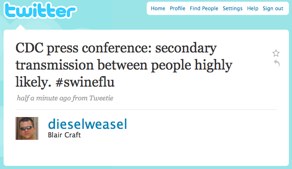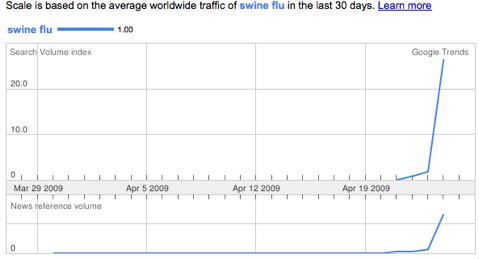The Latest from TechCrunch |  |
| Portfolio Magazine Gets Liquidated. There Goes $100 million. Posted: 27 Apr 2009 08:36 AM PDT
Conde Nast is shutting down its glossy business magazine Portfolio, two years after its launch. Conde Nast famously poured $100 million to launch the publication, which went on an expensive hiring spree in 2007 in its attempt to take on Fortune, Forbes, and Business Week. The magazine always seemed to me to have an unhealthy fixation with Wall Street and the hedge fund boom over other industries, but as Wall Street cratered nobody wanted to read those stories anymore. The drop in print advertising, down 26 percent in the first quarter, didn’t help matters either. Portfolio saw itself in the same vein as the Fortune magazine of the 1930s, filled with lush photographs and long narratives. But that formula doesn’t work in an age where business is about speed, not leisure or luxury. It also doesn’t work in an age where monthly magazines in general are increasingly challenged by the wealth of instantaneous business news available on the Web. (And you thought the daily newspapers had it tough). Portfolio’s insistence on favoring its print over its Website content also helped to hasten its demise. If you are going to start a magazine these days, the Website has to come first. The magazine companies still don’t realize this simple fact. Finally, there will always linger the question of leadership. The magazine’s editor Joanne Lippman alienated and drove away much of her star staff. I know people who used to work there, and the stories I always heard were ones of disarray, which is to be expected at any startup, even one with $100 million in corporate backing. Did anyone here even read Portfolio magazine. Does anyone here even read magazines? Oh well, another one for the deadpool. (Disclosure: I used to work at Fortune a long time ago). Crunch Network: MobileCrunch Mobile Gadgets and Applications, Delivered Daily. |
| Time Magazine Throws Up Its Hands As It Gets Pwned By 4Chan Posted: 27 Apr 2009 07:35 AM PDT
The hackers of 4Chan have succeeded in completely gaming Time Magazine’s online poll for its Time 100 list of the most influential people on the planet. At the top of the list is Christopher Poole, aka Moot, the founder of the 4Chan online forum, whose members used some coding to get his name to the top of the list. Not only did they help moot win the poll, but they also arranged the next 20 names to spell out “Marblecake, also the game.” Marblecake is a lewd sexual reference, but is also supposedly the name of the chat room where one of 4Chan’s online collective actions, Project Chanology, originated.
This is just the “people’s choice” list, not the official list picked by Time’s editors, but still it makes you wonder whether the editors at Time bother to read anything on the Internet. It is pretty well-documented that the 4Chan community was trying to manipulate the poll results. Nevertheless, Time just threw up its hands and named Moot the winner. Time is obviously aware of the controversy, but tries to justify the choice nonetheless by writing that:
Except Time.com’s technical team didn’t do a very good job, because the top 21 names still spell out the Marblecake sentence. Time knows it was pwned by 4Chan, but simply throws up its hands. Time.com’s managing editor Josh Tyrangiel tries to defuse criticism by admitting that the poll is meaningless. He says, “I would remind anyone who doubts the results that this is an Internet poll. Doubting the results is kind of the point.” Or maybe the point is to name an Internet celebrity and create a controversy so that people click through to read the results. Well played. Crunch Network: CrunchGear drool over the sexiest new gadgets and hardware. |
| Seeqpod Knocked Down, Will It Ever Get Up? Posted: 27 Apr 2009 06:45 AM PDT
At the end of last month, we broke the news that the Emeryville, CA-based company filed a petition for Chapter 11 with the U.S. Bankruptcy Court of the Northern District of California. Now it looks like the service, which many third-party developers use as the underlying foundation for their own offerings, has gone completely dark for the past couple of days. Update: site just went back up with a maintenance notice, about 5 minutes ago (10 AM EST) Apparently, after going down Friday afternoon Seeqpod at one point claimed on its website that it was having server issues and that the service would be restored once the technical problems were solved, but the site went down again 45 minutes after the notice was published and has been unavailable since 10:30 PM EST Saturday night. There’s still no 100% certainty that Seeqpod has in fact permanently closed shop. In fact, MP3 Newswire in a post says it has been in touch with Seeqpod CEO Kasian Franks yesterday and that he reportedly stated the company is merely moving servers. Furthermore, MP3 Newswire quotes Franks as having said that the company is in acquisition talks with a “large media company that was a competitor to Apple”. This could of course be a well-considered strategy to let people know it’s up for sale at all (which under the circumstances, would not be much of a surprise), hoping to squeeze a deal out of say, Sony or RealNetworks. In case this is all just talk and an acquisition never happens, things are not looking too good for Seeqpod, who despite the fact that it claims not to host any files on its own servers has become the target of multibillion dollar lawsuits by music labels like Warner Music, Capitol Records and EMI. The company has raised $7 million from undisclosed angel investors to date. Crunch Network: CrunchGear drool over the sexiest new gadgets and hardware. |
| Brandtology Raises $1.35 Million For Advanced Social Media Tracking Posted: 27 Apr 2009 06:03 AM PDT
Despite its military-sounding name, these centres actually help Brandtology customers make ‘timely and informed strategic decisions’ based on an advanced online conversation tracking system, which mines blogs, forums, micro-blogging services etc. for opinions, aided by specialists who monitor the system for clients around the clock. Brandtology in a statement said it will use the fresh capital to further expand its services in North Asia, where it sees most opportunities for growth. The investment in Brandtology is the first to come out of the early-stage fund Seed Ventures IV Pte., a $13.3 million venture fund Walden International set up as a vehicle for small-scale financing rounds. The firm's funds total over US$1.9 billion in committed capital. Crunch Network: MobileCrunch Mobile Gadgets and Applications, Delivered Daily. |
| Wesabe Meets Mint In The iPhone Finance App Arena Posted: 27 Apr 2009 02:10 AM PDT
So how do the apps stack up? Well, there are two key differences: Mint’s looks nicer, but Wesabe’s is more dynamic. What I mean by that is, with Mint’s iPhone app you can only see an overview of your finances, and look at things like the budget you set up online. With Wesabe’s iPhone app, everything is editable. And that’s a nice feature because more than a few times with Mint, I have seen a transaction categorized wrong, but had to login on my computer to edit it. One cool feature that comes out of this ability to edit and add transactions from the app is that you can use your phone’s GPS to geo-locate wherever you made a purchase. This means you won’t have to type out the name of every merchant if you really want to take a hands-on approach and enter every purchase you make manually. The app also allows you to tag items on the fly, which is core to Wesabe’s offering. If you’re really worried about security, you’re probably not going to use either of these apps. But one nice thing Wesabe’s features is a separate security layer that allows you to set a password for accessing the app. This is great if you don’t have a password set on your iPhone and worry about losing your phone and someone seeing your finances. Wesabe’s iPhone app gives you access to all the accounts you set up online through the service. Unfortunately, while you can sign up for a Wesabe account through the app, you cannot import any bank accounts or credit card accounts through it — you’ll have to go to a computer to do that. Wesabe CEO Marc Hedlund tells me that functionality will be available in an upcoming release of the iPhone app. Ultimately, the choice of which app you’re going to use on the iPhone will come down to which service you use. But if you’re deciding which to sign up for and being able to edit your finances easily on a mobile device is important to you, than Wesabe may be a good choice. Find the Wesabe app available for free in the iTunes App Store. Crunch Network: CrunchBoard because it’s time for you to find a new Job2.0 |
| Confirmed: Former AOL Exec Mike Jones To Take COO Role At MySpace Posted: 27 Apr 2009 01:06 AM PDT
An announcement will be made later this morning. Jones and Van Natta will join Jonathan Miller, the CEO Digital Media, at MySpace’s Los Angeles offices today to address employees. Jones is a well respected entrepreneur who founded Userplane, a video chat service that added social features to dating and other sites. Userplane was bought by AOL in 2006 for around $40 million. The acquisition was made at the time that Jonathan Miller was the CEO of AOL, and Jones knows Miller well. As we said in an earlier post about the changing of the guard at MySpace, News Corp. is making a clean sweep of the top executives. Cofounder and CEO Chris DeWolfe is out. Cofounder and President Tom Anderson is is having "discussions" about "assuming a new role in the organization." Our guess is that the final Cofounder, CTO Aber Whitcomb, is next to go. Jones left AOL in 2008 to start a new company, Tsavo, which sources tell us is off to a very fast start. The company raised a substantial amount of capital from American Capital and has made a number of acquisitions. Sources also say that the company is profitable. Jones will be stepping into a board of directors and advisor role, and he certainly leaves the company far more structurally sound than his new boss Owen Van Natta did with his own Project Playlist. This is the kind of executive that many hoped Miller would bring in to run the massive MySpace property, which remains one of the largest sites on the Internet despite lagging badly behind Facebook in growth. Jones won’t have the same authority in the No. 2 position at the company, but if Van Natta is smart enough to give him room to run it will be a good sign for the company. Another good sign - Jones is a long time user of MySpace and is very active on the site. CEO Van Natta barely has a presence, and Miller isn’t yet on the site. Crunch Network: MobileCrunch Mobile Gadgets and Applications, Delivered Daily. |
| Have Kindle, Will Travel — And Stay Up-To-Date Thanks To Offbeat Guides Posted: 26 Apr 2009 10:00 PM PDT
Starting tomorrow, you’ll be able to find 500 of the company’s newest guides in the Kindle store at prices ranging from $3.99 for smaller cities to $7.99 for larger ones. Here’s why these are great. Just like the Offbeat Guides regular guidebook products, its Kindle-ready guidebooks are way more up-to-date than traditional guidebooks. While there have been some guidebooks available on the Kindle in the past, most are only updated once a year. Offbeat Guides are updated every month. This means they can include information such as real-time events for specific cities, like concerts or festivals. It also means the guides can have a Kindle menu option to find out something going on in the city you are visiting that night. For tourists who don’t know anyone in a particular city, that’s a great feature. There are a couple downsides. Naturally, because the Kindle only handles grayscale images, you won’t get the full color pictures you usually find in other tour guides. And because the Kindle’s screen isn’t ideal for displaying maps, tailored, local maps that are a part of Offbeat Guides regular guides aren’t included here. But, at 10.2 ounces (for the latest version), the Kindle is likely lighter than regular tour guides. And, if you’re planning a multiple city trip, you can obviously load up a bunch of these guides on one Kindle. One thing that particularly excites me is the fact that you can also view these on your iPhone if you go somewhere and don’t feel like carrying around a Kindle. Because the Kindle app on the iPhone stays in sync with the Kindle content, you can bookmark pages and look at them later on your phone. Offbeat Guides has been working on these Kindle-tailored guides for 6 months now, CEO Dave Sifry tells me. He also notes that there are 5 times as many cities available as compared to other guides. Right now, if you plan on traveling to a city often and want the most up-to-date guide, you’ll have to buy a new one each time. But Sifry says they will explore the possibility of having subscriptions for certain cities if customers demand that. Such a feature may even be useful to locals of a particular city to know what is going on. But the focus right now remains on leisure and business travelers, he says. Find a full list of the Offbeat Guides Kindle options here. Crunch Network: MobileCrunch Mobile Gadgets and Applications, Delivered Daily. |
| TC/CG Meet-up: Important Helsinki Update Posted: 26 Apr 2009 09:58 PM PDT
NOTE - The new start time is now 8pm. We’ve decided to have the meet-up at A21 on Annankatu 21 [Google Map]. PLEASE RSVP ASAP so I can offer them a head count. N.B. If you have a start-up to discuss, please have some information handy, preferably in electronic form. It will probably be hard to do demos unless they’re on a mobile phone, but if you contact me beforehand we can probably sit down to look at your product on a laptop.
UPDATE - Nokia is chipping in from 8pm-9pm! For last minute changes follow me on Twitter. See you in Helsinki! Crunch Network: CrunchBoard because it’s time for you to find a new Job2.0 |
| AOL Launches Online “News Magazine” PoliticsDaily Posted: 26 Apr 2009 08:53 PM PDT  AOL is adding a twist to old-fashioned political journalism with the launch of its new political news and blog site, PoliticsDaily.com. The site, which will primarily focus on in-depth political commentary as opposed to breaking news, will only provide original content, from long-form analysis to blog posts on issues in the U.S. political landscape. Led by former New York Times Washington Correspondent, Melinda Henneberger, PoliticsDaily wants to tie the old media’s in-depth political analysis with a sustainable digital medium PoliticsDaily is the brainchild of Martin Moe, senior vice president at AOL and is built under Bill Wilson's new MediaGlow division, which is building new content brands distinct from AOL itself. MediaGlow, which recently launched topic directory Love.com, runs AOL News, Engadget and TMZ.com, among other properties. PoliticsDaily is part of the AOL News network, which received more than 27 million unique visitors in March, according to comScore stats. New York Times Digital by comparison had close to 46 million unique visitors in March. PoliticsDaily has enlisted a “dream team” of experienced political journalists from both new and old media, including Walter Shapiro, former columnist for USA Today and former Washington bureau chief for Salon; Jill Lawrence, former national political correspondent for USA Today and columnist for the Associated Press; Carl Cannon, former Washington bureau chief for Reader's Digest and White House correspondent for the National Journal and the Baltimore Sun; Lynn Sweet, blogger and Washington Bureau Chief of the Chicago Sun-Times; and Patricia Murphy, founder of Citizen Jane Politics, a non-partisan website for women. The site will include blogs such as “Woman Up,” a blog focused on political issues from a woman’s perspective; “The Daily FLOTUS,” a blog which focuses on First Lady Michelle Obama; and “The Cram,” a student-focused blog on political news. Consumers are more frequently looking online news for political news, as we saw in the past presidential elections and during the current downturn in the economy. PoliticsDaily hopes to be a mainstream source of analysis and news and shuns the idea of being a news aggregator. While the all-original content includes both long-form articles and blog posts, the site will not be primarily focused on breaking political news—perhaps leaving the real-time, short-form news to other political news competitors like The Politico,The New York Times, The Huffington Post and the A.P. The competition in the political news sphere is tough, especially online. PoliticsDaily will have to build a credible brand with its original content, going up against media organizations that have long been offering in-depth analysis, like the New York Times, The Washington Post, The Nation, The Atlantic and The Huffington Post. PoliticsDaily will also face some competition from The Politico, which incorporates blogs, breaking news, interactive multimedia features and in-depth reporting into one site. And while the New York Times and Washington Post are hemorrhaging money from their print publications, their in-depth political coverage and analysis on their websites is strong, deploying a wide array of multimedia, blogs and long form commentary. News broadcasters sites also provide popular political coverage—CNN.com. MSNBC.com, and FoxNews were among the top five trafficked news sites following the election in November. Moe maintains that PoliticsDaily’s long-form magazine content will differentiate the site from The Politico and other real-time focused news sites. Moe pledges that the differentiation between PoliticsDaily and the Huffington Post will be even more clear. Moe says that while the Huffington Post is largely a content aggregator, has a leftward bent, and doesn’t pay many of its bloggers, PoliticsDaily will be 100% original content from “experienced” paid writers, and will be “poly-partisan” with perspectives from the liberals, centrists and conservatives. Of course, with the financial backing of AOL, PoliticsDaily has the advantage of being able to pay all those editors and reporters. But if PoliticsDaily is supposed to be an online new magazine, why isn’t AOL’s sister subsidiary Time Inc. running it? Crunch Network: CrunchBoard because it’s time for you to find a new Job2.0 |
| Posted: 26 Apr 2009 07:38 PM PDT
The two sides are discussing the possibility of getting Verizon version of the iPhone ready for 2010, sources tell USA Today. There are likely two reasons it would take until next year. The first, is that Apple’s exclusive contract with AT&T runs through next year. The second is that a Verizon version would presumably have to be CDMA-ready, which means the innards of the iPhone would have to be slightly tweaked, as the current iPhone is GSM-only (which AT&T, and most other cell networks run on). Perhaps now we know why it’s been reported recently that AT&T was pushing hard to get Apple to extend its exclusive deal another year, into 2011. Verizon is AT&T’s main rival in the US, and is actually larger. But Verizon lacks the one device that people are switching networks just to get. In announcing its most recent earnings, AT&T said that as many as 40% of all customers who sign up for iPhone contracts are new to AT&T — that is huge. But here’s something to think about: A new iPhone is almost for sure going to launch sometime this summer. It will be AT&T only — and, you will presumably have to sign up for a new 2-year contract to get it (and certainly you will have to do that to get it for the subsidized price). If people know a Verizon iPhone is possible in 2010, will a lot of potential buyers hold off? I think so. Hell, given the recent issues I’ve had with AT&T’s network, I’d consider not getting the new iPhone if Verizon was really a possibility for next year. But it’s still a big “if” at this point. Who knows, Apple would just be talking with Verizon (the company that originally spurned the iPhone) just to increase the pressure on AT&T to give them a sweeter deal. You know, negotiations 101. But if Apple truly does envision the iPhone as a product that it wants to dominate the market with, it will need to get onto other networks eventually. It seems inevitable, but is 2010 the year? Crunch Network: CrunchBase the free database of technology companies, people, and investors |
| Facebook To Let Others Play In Its Stream Posted: 26 Apr 2009 05:38 PM PDT
Facebook is expected to announce that third-parties will now have access to data from the site that was previously unavailable, before an event set to take place at 4PM PST tomorrow. The Wall Street Journal has a few of the details, including that developers should be able to access the all-important photos and videos that users upload. Apparently, these third-party developers, assuming they get users’ permission to use this data, could build their own sites and services with some of it. Also of note is that apparently Facebook will begin supporting more open standards for the transporting of data. It’s not yet clear exactly what this will mean, but presumably it could help alleviate some of the issues I wrote about last week in noting that Facebook, Google and others were creating what were essentially proprietary profiles, that forced all of us to actively use and update all of their services. I’ll be very interested to see what this means when it comes to Facebook Connect. If Facebook really is opening most of its data, it would seem to me it’s a smart move to stop some of the momentum that smaller rivals, like Twitter, are getting. After all, Facebook still has its big stick — over 200 million users and more importantly, their data. Now it may be able to fully swing it. [photo: flickr/rachel thecat] Crunch Network: CrunchBoard because it’s time for you to find a new Job2.0 |
| Pleo Creator Ugobe Declares Bankruptcy Posted: 26 Apr 2009 03:01 PM PDT  The first real casualty of the economic crisis has emerged, and it's a lovable robotic dinosaur. Decreased demand for expensive toys has left Pleo's creator, Ugobe, wallowing in debt. As a last ditch effort to remain solvent, they're going to try to auction off the rights to Pleo, but there's no guarantee that the poor critter will ever be made again. Pleo has always been a favorite over here at CrunchGear, so we put together a little goodbye tribute video in case the adorable robosaurus is indeed extinct. The first real casualty of the economic crisis has emerged, and it's a lovable robotic dinosaur. Decreased demand for expensive toys has left Pleo's creator, Ugobe, wallowing in debt. As a last ditch effort to remain solvent, they're going to try to auction off the rights to Pleo, but there's no guarantee that the poor critter will ever be made again. Pleo has always been a favorite over here at CrunchGear, so we put together a little goodbye tribute video in case the adorable robosaurus is indeed extinct. |
| Al Gore Defends His Right To Invest In Green: “Congresswoman, You Don’t Know Me.” Posted: 26 Apr 2009 02:21 PM PDT On Friday, during a Congressional hearing on the Obama Administration’s proposal for a cap-and-trade system to curb greenhouse gases, Al Gore had to defend his honor. Marsha Blackburn, the Republican Congresswoman from Gore’s home state of Tennessee, questioned his motivations behind supporting the proposal because of his investments in green startups through his role at Kleiner Perkins, where he is a partner. (Watch the video above, courtesy of Talking Points Memo). Blackburn comes off as clueless and Gore comes off as defensive. She didn’t seem to know too much about Kleiner Perkins other than that it is a “capital firm” and that it has invested “$1 billion in 40 companies that are going to benefit from cap-and-trade legislation,” or at least that is what she gathered from an old New York Times Magazine article. “Are you aware of that company?” she asked him. Then she asked Gore if he stood to personally benefit financially from these investments, and that set him off:
He pointed out that “every penny” he makes from these investments, his book, and movie go to the nonprofit Alliance For Climate Protection. Blackburn responded by saying that she was just trying to get clarity on the issue, but Gore was having none of it:
Is this video from a parallel universe or did the Republican Party become anti-capitalist all of a sudden? Crunch Network: MobileCrunch Mobile Gadgets and Applications, Delivered Daily. |
| Swine Flu Spreads Panic Over The Web Posted: 26 Apr 2009 12:51 PM PDT
Earlier today, the U.S. declared a public health emergency over the Swine Flu, after confirming 20 cases of the flu spreading to humans in New York, Ohio, Kansas, Texas and California. More than 80 people have died in Mexico from the disease, which has potentially spread to other countries, including Canada and France. Although Federal officials are urging Americans not to panic about the disease, fear of contracting the potentially deadly flu is quickly spreading over Twitter, Google, and blogs across the web. Swine Flu is the top trending topic on Twitter at the moment, with users rapidly tweeting about the latest news about the disease, including whether it has spread to other states, the Center for Disease Control’s announcement, etc.
Google Trends reports that “Swine Flu Ohio” is the 27th most popular search keyword currently, with searches for the “CDC” and “Swine Flu Symptoms” also making the top 100 keyword searches on Google. Google Maps have also been created to chart the spread of the Swine Flu. Below is a Google Map created by a bio medical engineer, that charts suspect and confirmed cases of the Swine Flu in the U.S. and Mexico.  Technorati’s index, which graphs the number of times the search term occurs in blog posts across the web, shows that mentions of Swine Flu in blog posts has risen sharply from Friday to nearly 2800 blog post mentions today. Keyword popularity across the Blogosphere This chart illustrates how many times blog posts across the Blogosphere contained the following keywords. Crunch Network: MobileCrunch Mobile Gadgets and Applications, Delivered Daily. |
| Here Comes Twitter Spam And How To Fight It Posted: 26 Apr 2009 11:37 AM PDT
A spam-less Twitter feed might just be too good to be true. Spam is becoming an increasing problem on Twitter and something has to be done to separate the wheat from the chaff. Spammers are using Twitter as a tool by replying to your @username, which then causes the Tweets to show up in your timeline. There isn’t really a way to filter Twitter spam directly from a Twitter client. But there may be soon. Loic Le Meur has proposed to add a “report as spam” button to the Twitter desktop clients his company has created, Twhirl and Seesmic Desktop. This button would flag the spammer to Twitter (or to a separate database of users) and Seesmic or Twhirl could then exclude the spammer from its client apps after a sufficient number of users report them as spam. Le Meur also says that the clients would manually check the potential spammers to ensure that they are actually spammers. After the clients are established as spammers, Twitter could then delete or block the user accounts. Le Meur says that his Twitter clients will soon include a “report as spam” button and is calling on fellow popular Twitter clients, Tweetdeck and Tweetie, to follow suit. The one potential issue with the flag button, says Le Meur, is that Twitter prefers spam to be reported by a direct message to its spam account “@spam.” But you need have @spam to follow you first (it seems to be autofollowing) before hitting the flag button on a Twitter client. It’s an extra step the user would have to take to make the button usable, says Le Meur.
Flagging is a good idea and a great first step to battling spam but what Twitter really needs is an Akismet-like plug-in. Akismet, created by Wordpress developers, filters link spam from blog comments and trackback pings for blogs. When a new comment, trackback, or pingback comes to a blog site, it is submitted to Akismet, which runs hundreds of tests on the comment and returns a thumbs up or thumbs down on whether it is spam. Akismet says that its plug-in has caught 10.7 billion spam comments from blogs since its launch in 2005. There are a few Twitter applications that let you flag possible spam, but none are tied to the Twitter desktop clients, like Seesmic Desktop or Tweetie. Topify, a nifty service we reviewed recently, gives you a more comprehensive version of the standard New Follower email offered by Twitter, by providing the user's Bio, Follower/Following numbers, the user's most recent tweets and the ability to block and unfollow potential spammers directly from the New Follower email. Twerp Scan scans through your followers and flags Twitter users who could be potential spammers. You can control the filtering options that determine who is a spammer (i.e. number of followers vs. following). But Twitter may have to develop or license its own spam blocking software if the problem becomes more prevalent. >Information provided by CrunchBase Crunch Network: CrunchBoard because it’s time for you to find a new Job2.0 |
| The Sorry State Of Online Privacy Posted: 26 Apr 2009 09:52 AM PDT
The Cloud is looming large, offering us ways to store and share our data in ways that were never before possible. We can effortlessly share our documents and photos with our families and friends, while maintaining control over their spread using powerful granular privacy controls. But it’s quickly becoming clear that the cloud isn’t ready for us. Because the services we rely on are letting us down with a frequency that is simply unacceptable. I’ve been putting this post off for a while, mostly because I didn’t want to point to a single breach and call it a trend. But in only the last two months, we’ve covered at least three major web services that suffered security lapses tied to software bugs or scaling issues. In our posts covering these problems, one of our commentors will inevitably say something along the lines of, “that’s what you get for uploading your data to X service“. And the more problems I see, the more I’m beginning to agree with them. For a recap, let’s revisit some of the problems we’ve recently seen. In March I wrote about a bug in Google Docs that would share your files with people whom you’d never given access to. Granted, it would only share these files with contacts you’d previously interacted with, and not the entire world, but this did little to ameliorate the issue - in some cases it would be better to share a supposedly private document with a stranger than a coworker. Two weeks later, we were alerted to a bug on Facebook that would allow users to circumvent any ‘limited profile’ lists they’d been placed on by their friends. For example, if you had placed your boss on a ‘Limited’ profile list so they couldn’t see your latest party photos, they’d be able to get around it. This ‘exploit’, if it could even be called one, was so easy to carry out that I’m sure many people did it accidentally. Finally, earlier this week Twitter posted a note to its Status blog saying it was having issues with “misdelivery of direct messages”. In other words, some supposedly private messages were being routed to the wrong users. Given Twitter’s problems with bugs in the past this didn’t come as a huge surprise, but it’s unnerving nonetheless. When faced with such security lapses, most services try to downplay them by pointing out how few people (relatively speaking) were affected. In the case of the Google Docs issue, Google promptly explained that only .05% of all documents were wrongly shared. But when we’re talking about userbases of millions, even an apparently trivial percentage becomes significant, with thousands of people affected. What’s worse, I’m sure this sort of phenomenon is far more common than we realize. The other services involved just aren’t big enough (or honest enough) for anyone to notice. So why is this happening? There seems to be an accepted notion among many engineers that as their service scales, there is no way that it will be 100% secure. To some extent, I acknowledge and agree with this. Very smart people are always going to be trying to access valuable data by whatever means necessary, and complex security exploits are unfortunately a fact of life on the web. But that doesn’t mean that it’s acceptable for the service to wrongly share user data simply because of a bug. It’s the difference between having your bank apologize for losing your money because someone robbed it, and it telling you that the teller accidentally withdrew a few thousand dollars from your bank account and handed it to someone else. This sort of thing just can’t be happening. My real issue with these security lapses isn’t so much about the misdirected messages or the wrongly shared photos - the odds of these being truly damaging really are quite low. It’s that these problems serve to undermine the public’s trust in ‘the cloud’. Once we get past the security problems, having our data immediately accessible no matter where we are is incredibly valuable - and probably inevitable. It’s only a matter of time before our health records are going to be stored online in some form, simply because having instant access to them can be lifesaving. But if the public loses faith in the integrity of their data stored online, or the security measures protecting it, then it could take years to regain its trust. So what can we do? Though I’ve dabbled in programming for years, I unfortunately am not an engineer by trade (a fact that I’m sure opponents of this post will promptly point out to show that I can not possibly know what I’m talking about). But the answer seems clear regardless. If an application is cracking under load, or is too complex for its own good, then new signups and features should be put on hold until the damn thing actually works properly. The word ‘private’ should not mean “this will remain hidden until we accidentally break something”. To close, I want to make clear that I understand that these engineers are dealing with extremely difficult problems, scaling their incredibly complex services at unprecedented rates. And I respect the hell out of that. But the more often issues like these pop up, the more the general population is going to distrust the security protections of these online services, no matter how good they eventually become. Which is why we need to sort these problems out now. Crunch Network: CrunchBoard because it’s time for you to find a new Job2.0 |
| You are subscribed to email updates from TechCrunch To stop receiving these emails, you may unsubscribe now. | Email delivery powered by Google |
| Inbox too full? | |
| If you prefer to unsubscribe via postal mail, write to: TechCrunch, c/o Google, 20 W Kinzie, Chicago IL USA 60610 | |






 We’ve
We’ve  I used to think the Kindle was stupid. Then I bought one and realized I was
I used to think the Kindle was stupid. Then I bought one and realized I was 

 I’ll be in Helsinki next week and I’d like to plan a very informal meet-up on Tuesday, April 28 at 8pm. All those attending, please email me at john@crunchgear.com with the subject line “RSVP HELSINKI.”
I’ll be in Helsinki next week and I’d like to plan a very informal meet-up on Tuesday, April 28 at 8pm. All those attending, please email me at john@crunchgear.com with the subject line “RSVP HELSINKI.”
 At the risk of repeating myself for the millionth time, in many peoples’ minds, the Achilles’ heel of the iPhone is the network it’s on in the US: AT&T. Since the day it was announced as being exclusive to that provider, people have been wondering one thing: How long until it’s on Verizon? Rumors have surfaced time and again about the possibility, but today brings perhaps the most concrete news yet that the two sides are talking.
At the risk of repeating myself for the millionth time, in many peoples’ minds, the Achilles’ heel of the iPhone is the network it’s on in the US: AT&T. Since the day it was announced as being exclusive to that provider, people have been wondering one thing: How long until it’s on Verizon? Rumors have surfaced time and again about the possibility, but today brings perhaps the most concrete news yet that the two sides are talking. Seeing the
Seeing the 





No comments:
Post a Comment